Abstract
As a vital part of the Eurasian temperate grassland, the Chinese temperate grassland is primarily distributed in the Inner Mongolia Plateau. This paper focuses on mapping temperate grassland dynamics from the 1980s to the 2010s in Inner Mongolia, which was divided into temperate meadow steppe (TMS), temperate typical steppe (TTS), temperate desert steppe (TDS), temperate steppe desert (TSD) and temperate desert (TD). Multi-source features, including multispectral reflectance, vegetation growth, topography, water bodies, meteorological data, and soil characteristics, were selected based on their distinct physical properties and remote sensing variations. Then, we applied deep neural network (DNN) models to classify them, achieving an accuracy of 79.4% in the 1980s and 81.1% in the 2000s. Additionally, validation in the 2010s through field reconnaissance demonstrated an accuracy of 72.7%, which was acceptable, confirming that DNN is an effective method for classifying temperate grasslands. The results revealed that TTS had the highest proportion in the study area (39%), while TMS and TSD had the lowest (8.2% and 8.1%, respectively). Grassland types have the distribution law of aggregation; according to statistics, 61.1% of the grassland area remained unchanged, and the transition zone between adjacent grassland classes was highly easy to change. The area variation mainly came from TTS, TDS, and TSD, but not TD. The mutual transformation of different grassland types occurred mainly in adjacent areas between them. This study demonstrates the potential of DNN for long-term grassland mapping and provides the most comprehensive classification maps of Inner Mongolia grasslands to date, which are invaluable for grassland research and conservation efforts in the area.
1. Introduction
Grassland is a vital green covering layer on the earth’s surface, second only to forest. It is a significant part of the terrestrial ecosystem and plays a crucial role in regulating the global carbon cycle and climate change. In recent decades, with the intensification of human activities and the impact of global climate change, a series of problems have occurred, such as desertification degradation, soil erosion, and biodiversity disorder [1,2,3]. The spatial distribution and change in grassland types are vital indicators for monitoring grassland degradation and the basis of grassland monitoring and management [4]. How to quickly and accurately classify and map grassland types in a large spatial and long temporal scale remains a particularly important and difficult task.
The traditional vegetation map drawing method is mainly based on field investigation, supplemented by remote sensing image verification [5]. The field survey mapping methods usually combine natural environment elements that can reflect the distribution law of vegetation. Then, we obtain actual vegetation survey data in the route and sample survey, and manually correct and divide map boundaries of each grassland types after a visual interpretation by cartographers through satellite images [6]. Nowadays, vegetation–habitat, and climate–land–vegetation classification systems are mainly used in China. Both are based on field surveys. Chinese grassland was divided into 18 types, including five temperate grassland types [7]. Over the past few decades, only one nationwide grassland type survey map of China has been produced, which was completed in the 1980s. This map was created through manual delineation and over 20 years of field investigations by over 200 scientists [8,9]. The field survey mapping methods can record the distribution and growth of grassland types in detail and accurately. However, this high-cost, low-efficiency investigation is unsustainable and greatly influenced by the subjective judgment of the investigators. It is possible to carry out the fine classification mapping of large-scale grassland with remote sensing.
Remote sensing technology has been widely used in grassland research because of its advantages of a wide detection range, strong comprehensiveness, and fast and economical data acquisition. Grassland remote sensing classifications can be divided into three categories according to different targets. The first takes grassland as a land cover type, which is mostly distinguished by vegetation coverage and biomass. The research results are relatively mature, and regional or global land use/cover databases in different resolution have been established, like ESRI LULC, WorldCover, etc. [10,11,12,13,14,15]. Nonetheless, such studies were limited by the spatial resolution of the images and only extracted grassland areas within those constraints. Grassland has the characteristics of a complex structure and wide variety and mixed growth of species, but the spectral characteristics of different grassland types are very similar, which makes it difficult to identify large-scale grassland types only through spectral characteristics [16]. The second is to classify the fine grassland vegetation species or communities. With the development of hyperspectral and UAV remote sensing in spatiotemporal resolution, some scholars focus their research on vegetation species classification [17,18,19,20] and the extraction of grassland invasive species [21,22]. These studies showed good effects on the identification of grassland species with significant spectral differences and may improve the accuracy of species classification. However, due to the high cost of acquiring UAV and hyperspectral images, the current research is limited to a small area and cannot monitor the grassland types with a long time series and large scale. Thirdly, some research progress has been made in the classification of grassland types [23,24,25]. But there is no uniform classification standard and method based on different targets of grassland utilization between different countries [26]. These research results are difficult to use for spatiotemporal comparison and analysis. In addition, there are fewer remote sensing classification applications in the long-term series of temperate grassland type mapping in Inner Mongolia. A new grassland type mapping method named Accumulated Rate of Normalized Difference Vegetation Index (NDVI) Change Index (ARNCI) has been proposed based on NDVI Time-Series data in Eurasian temperate grassland [27]. The mapping results included Inner Mongolia, but the research only focused on two periods of 1980s and 1990s; moreover, this method introduced four transitional grassland types and its classification accuracy depends on the ANRCI threshold setting of multiple experiments.
With the rapid development of artificial intelligence (AI) technology, machine learning (ML) and deep learning (DL) provide new methods for constructing the fine classification model of grassland types. There are some researchers who have made progress in remote sensing vegetation classification by applying multi-source data with ML methods. For example, Meng et al. [24] successfully extracted the Kobresia pygmaea community in alpine meadow grassland on the Qinghai–Tibet Plateau using the random forest method, achieving an overall accuracy ranging from 74.06% to 83.92%. They enhanced the classification accuracy by integrating multi-source data, including satellite vegetation indices, phenological characteristics, image texture, and topography. In addition, Meng et al. [28] applied four ML methods like the gradient boosting decision tree (GDBT), to classify temperate grassland in Inner Mongolia in 2018 and 2019 based on UAV and MODIS NDVI, and the highest overall accuracy reached 72.17%, but the research only focused on two years. Compared to traditional ML algorithms, DL models offer faster and superior performance in handling large-scale, high-dimensional, and multi-source data due to their capability for automatic feature extraction, nonlinear representation, and end-to-end learning [29]. Recent studies have employed DL techniques to process multi-source data, enabling the capture of complex nonlinear interactions among vegetation characteristics, environmental variables, and spectral responses. Compared with traditional single-factor [30] or multi-factor [31] models, these deep-learning approaches have significantly improved both the accuracy and spatial coverage of biomass mapping [32,33,34]. For instance, Shi et al. [34] demonstrated that the model performance followed the order of deep neural network (DNN) > artificial neural network (ANN) > support vector machine (SVM) > multiple linear regression (MLR) in estimating the alpine grassland aboveground biomass. The DNN showed a superior capability in integrating diverse variables such as geospatial features, field measurements, and meteorological data. While traditional ML methods typically rely on manually engineered features and often struggle to model complex and nonlinear data patterns, DL models—particularly DNNs—can automatically learn hierarchical feature representations directly from raw data. This makes them especially well-suited for remote sensing tasks such as grassland classification, vegetation mapping, and multi-sensor data fusion. Temperate grasslands, which exhibit strong spatial zonality influenced by topography, soil properties, and climatic conditions [35,36,37], often show considerable variation in plant communities across different geographical and environmental contexts. DNNs demonstrate a notable advantage in capturing such spatial and ecological heterogeneity. Furthermore, techniques like dropout, batch normalization, and adaptive learning rate optimization enhance the stability and generalization capability of DNNs, making them highly effective for grassland mapping at the regional to continental scales.
Therefore, a multi-source data-driven method based on DNNs to map the distribution and changes of the temperate types in Inner Mongolia was proposed. The main objective of this study is to investigate when, where, and how temperate grassland types’ growth has stagnated or transformed in Inner Mongolia over the past 40 years, based on the prior knowledge of the 1:1 million vegetation map of the People’s Republic of China and the grassland resource vegetation map of Inner Mongolia, by integrating the apparent characteristics of temperate grassland types in remote sensing images, and habitat characteristics such as soil, climate, and topography, which determine grassland growth. We built the multi-source datasets and design DNN models to classify and predict the temperate grassland types of every ten years in Inner Mongolia, as well as analyzed its spatiotemporal changes. This study is critical to providing an effective mapping tool and vital information for grassland ecological environment change monitoring, grassland management and utilization, and grassland ecosystem rehabilitation.
2. Materials and Methods
2.1. Study Area
Inner Mongolia Autonomous Region is on the northern border of China, at 97°12′~126°04′ east longitude, and 37°24′~53°23′ north latitude. Inner Mongolia grassland is in the mid-latitude region with a temperate continental and monsoon climate; the annual average precipitation and temperature is 40~500 mm and −3~9 °C. The grassland growing season is from April to October. Its rainfall in the summer rainy season is short, and the precipitation accounts for 80% of the annual amount in the growing season [38]. Precipitation and temperature increased spatially from southwest to northeast. Inner Mongolia’s grassland is a crucial part of the Eurasian temperate grassland with a proportion of 67%, and 22% of the grassland area of China [23]. From east to west, it is mainly composed of five temperate grassland types: temperate meadow steppe (TMS), temperate typical steppe (TTS), temperate desert steppe (TDS), temperate steppe desert (TSD), and temperate desert (TD).
2.2. Overall Methodology
In this study, we first collected ground survey data (Section 2.3.1) and a set of multi-source features (Section 2.3.2), including meteorological, topographic, and soil variables that influence grassland growth, as well as remote sensing data that reflect grassland distribution. Using these inputs, we evaluated and compared the modeling performance of two approaches: a traditional ML method—LightGBM and a DL method—DNN (Section 2.4). The results demonstrated that the DNN model exhibits superior capabilities in handling complex data and making accurate predictions (Section 3.1). The field reconnaissance validation also gives us an acceptable result (Section 3.2). Based on this advantage, the DNN model was ultimately employed to generate large-scale temperate grassland classification maps across Inner Mongolia over a 40-year period from the 1980s to the 2010s (Section 3.3). Spatiotemporal dynamics and grassland type transitions were further analyzed and summarized (Section 3.3 and Section 3.4). The overall workflow is illustrated in Figure 1.
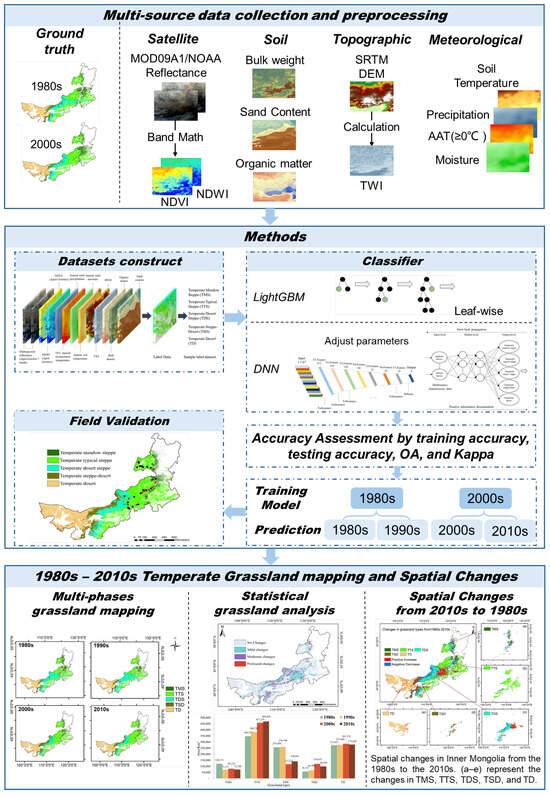
Figure 1.
Flowchart of this study.
2.3. Data Sources and Pre-Processing
Data selected in this research include field survey maps and classification features, which are shown in the following subsections.
2.3.1. Field Survey Maps
We collected the field survey data on temperature grassland types of Inner Mongolia in the 1980s and 2000s as ground truth and applied them to feature analysis and accuracy verification.
For the vegetation type map of the People’s Republic of China (1980s, 1:1,000,000) [9], The data were obtained by redrawing the 1:500,000 grassland type maps, grassland grade maps, and grassland utilization status maps for each province. These maps are mainly based on field mapping to measure biological yield, supplemented by remote sensing image verification. The data are provided by the Institute of Botany of the Chinese Academy of Sciences.
Grassland type survey products of Inner Mongolia, China (2009, 1:1,000,000). This data took remote sensing image as the background, superimposed with field survey data, and grassland type map of the 1980s and grassland subcategory map of 2001–2003 to comprehensively analyze the distribution law of grassland, and then drew the grassland types map. The data are provided by the Inner Mongolia Grassland Survey and Planning Institute.
To unify the data format, the data were pre-processed by spatial gridding, resampled to 1 km, with projection transformation, unified geographic coordinates (to WGS84), etc. Thus, the field maps of temperate grassland of Inner Mongolia in the 1980s and 2000s (1 km × 1 km) were obtained (Figure 2). According to the vegetation type map of China in the 1980s, the temperate grassland vegetation types were classified into five types: temperate meadow steppe (TMS), temperate typical steppe (TTS), temperate desert steppe (TDS), temperate steppe desert (TSD), and temperate desert (TD).
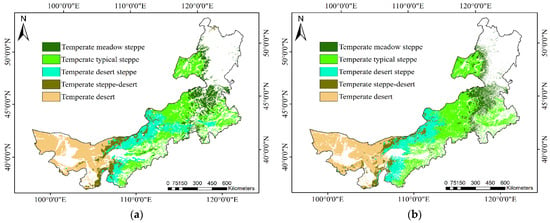
Figure 2.
Field survey maps of temperate grassland types in Inner Mongolia in the (a) 1980s, and (b) 2000s.
2.3.2. Classification Features
According to Ren et al.’s study [28,39,40,41,42,43,44], considering the characteristics of the study area and data availability, we proposed habitat factors, including topographic (digital elevation model (DEM) and topographic wetness index (TWI)), soil (organic matter, bulk density, and sand content) and meteorological data (precipitation, moisture index, soil temperature, and ≥0 °C annual accumulated temperature (AAT)); and apparent factors (NDVI, Normalized Difference Water Index (NDWI), and multispectral reflectance) to be used as classification features data. The characteristic data types are as shown in Table 1.

Table 1.
Multi-source classification features.
The apparent data were obtained from the MODIS surface reflectance product data MOD09A1 of NASA, USA (https://earthexplorer.usgs.gov). The spatial resolution of the data was 500 m, the temporal resolution was 16 d, and the time range was from 2000 to 2019, with NOAA CDR AVHRR: Surface Reflectance, Version 5 Data, and NOAA CDR AVHRR: Normalized Difference Vegetation Index (NDVI), Version 5 data of NOAA, USA. The data were downloaded and processed directly from Google Earth Engine (GEE) (https://earthengine.google.com). The spatial resolution of the data was 0.05 × 0.05°, the temporal resolution was 1 day, and the time range was from 1981 to 2019.
The meteorological data were from the reanalysis dataset ERA5-land released by European Centre for Medium-Range Weather Forecasts (ECMWF) (https://cds.climate.copernicus.eu). The spatial resolution of the data was 0.1 × 0.1°, the temporal resolution was 1h, and the time range was from 1981 to 2019. Annual accumulated temperature (≥0 °C) is calculated by average temperature. Moisture is calculated by precipitation and annual accumulated temperature [45].
The topographic data were from SRTM 90 m Digital Elevation Database V4.1 [46]. The spatial resolution was 500 m. The TWI data were calculated by the formula in [39].
The soil data were from the dataset of soil physical and chemical indices of temperate grassland in Eurasia (1981–2019) [47]. The dataset includes soil organic matter, sand content, and bulk density in two periods (1980–1999 and 2000–2019). The data were in TIFF format with a time resolution of 20 years and a spatial resolution of 1 km.
We consider the following factors: (1) the ground truth data were derived from extensive field surveys conducted by multiple experts over several years; (2) the distribution of temperate grassland types exhibits clear zonality, influenced by long-term interactions among climate, soil, and human activities, rather than abrupt annual changes; and (3) this study focuses on a decadal temporal scale. Based on these considerations, we processed the remote sensing, meteorological, soil, and topographic data by calculating their decadal averages. This strategy is expected to better align the multi-source features with grassland type distributions, thereby improving the feature–category matching and enhancing classification performance.
To unify data format, making the training sample and validation set, the data pre-processing work is implemented by the following software. Satellite imageries were batch-downloaded through GEE cloud platform [48]. Some pre-processing tasks were conducted on ArcGIS 10.8, such as mosaicking, clipping, cloud removal, band math, projection conversion to WGS84, resampling to 1 km, etc. Python 3.8 and MATLAB R2024a were used to integrate sample sets to facilitate input model training.
2.4. Classification Methods of Temperate Grassland Type
To evaluate which modeling approach is better suited for this grassland classification task involving high-dimensional features and large sample sizes, this study systematically assesses the performance of classical machine-learning algorithms, such as Light Gradient Boosting Machine (LightGBM), alongside deep-learning algorithms like deep neural networks (DNNs), focusing on classification accuracy and adaptability to complex data structures.
Before applying classification models, it is essential that we first construct appropriate datasets. Considering that grassland types are determined by multiple factors, this study incorporated all feature layers along with corresponding ground-truth labels. Due to the limitation of dataset collection, as before 2000, NOAA multispectral data were used which only include two bands, but, after 2000, MODIS multispectral data were used which only include seven bands. Therefore, the models designed in this study before and after the 2000s had different feature dimensions in the input layer. The construction process of the 2000s model is shown in Figure 3. For the 1980s and 1990s, the input was in 26-dimensional features, consisting of meteorological data (4 features), topographic data (2 features), soil data (3 features), NDVI data (1 feature), and April–October multispectral data (8 months * 2 bands, which means 16 features). For the 2000s and 2010s, the input layer was 67 dimensions features, which consisted of meteorological data (4 features), topographic data (2 features), soil data (3 features), NDVI (1 feature), NDWI (1 feature), and April–October multispectral data (8 months × 7 bands, which means 56 features). Based on ground survey data from the 1980s and 2000s, training and validation sample sets were constructed using pixels as the basic unit. As described in Section 2.2, all spatial data were resampled to a spatial resolution of 1 km. The dataset from the 1980s comprises 1,052,670 pixels, representing the total number of samples. Among these, the distribution of grassland types is as follows: TMS—11.45%, TTS—32.89%, TDS—24.36%, TSD—5.39%, and TD—25.9%. While the sample size and proportions for the 2000s differ slightly, they remain largely consistent. For model development, 70% of the samples were randomly selected as training data, with the remaining 30% used for testing.
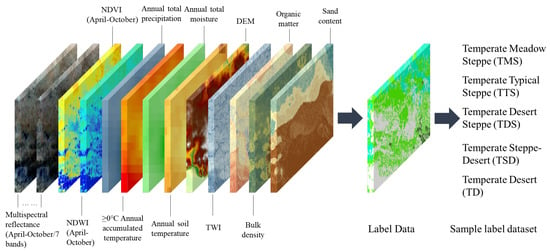
Figure 3.
Features and label dataset of the 2000s samples.
2.4.1. Light Gradient Boosting Machine (LightGBM)
LightGBM is an advanced gradient boosting algorithm based on decision tree learning, designed for high efficiency and scalability in handling high-dimensional and large-scale datasets [49]. Unlike traditional level-wise tree growth strategies, LightGBM adopts a leaf-wise growth approach by splitting the leaf with the maximum loss reduction, which leads to faster convergence and improved accuracy [50]. Compared to other conventional machine-learning algorithms such as Support Vector Machines (SVMs) and Random Forests (RF), LightGBM exhibits several advantages. SVMs tend to struggle with large-scale datasets due to their high computational complexity and memory consumption, especially when nonlinear kernels are used [51]. Random Forests, while robust and easy to use, often require more trees to achieve the same level of accuracy as boosting models, resulting in increased training time and reduced interpretability [52]. In contrast, LightGBM achieves higher computational efficiency, lower memory usage, and better scalability, making it more suitable for this study’s complex, high-dimensional classification tasks. In this study, the LightGBM classifier was configured with the following hyperparameters: learning_rate = 0.05, num_leaves = 64, min_data_in_leaf = 100, min_sum_hessian_in_leaf = 10, feature_fraction = 0.8, bagging_fraction = 0.8, bagging_freq = 5, lambda_l1 = 0.2, and lambda_l2 = 0.2.
2.4.2. Deep Neural Network (DNN)
A DNN structure mainly contains two parts, positive information dissemination and error back propagation [53,54], as shown in Figure 4. The weights connecting between neurons (or nodes) are randomly initialized and they can be regarded as a measure of similarity between two vectors. In the training process, continuous forward and reverse transmission is included. In the forward transmission, the input layer is converted to the output through the calculation of several nonlinear hidden layers, and the calculated output results are compared with the true results. In the back propagation, the gradient descent method is used to adjust parameters to minimize errors, and the final output result is constantly approaching the true result by reducing the adjustment weight of error back propagation [55].
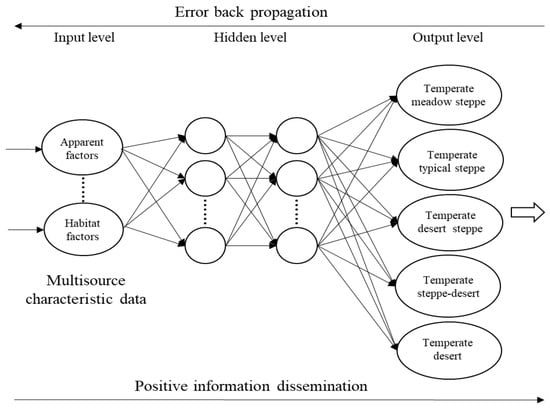
Figure 4.
Structure of DNN in the classification setting.
Its calculation principle is shown in Formula (1): The model learns a linear relationship between the output and input and obtains the output result A through the operation of nonlinear activation function F. The weight and bias term B are the parameters connecting the layers:
The DNN structure of the 2000s was divided into nine layers (Figure 5). The first layer was the input layer, and the experimental input was 1 × 67-dimensional images. It contains seven hidden layers, and the number of neurons is set to be 512, 256, 128, 64, 32, 16, and 16, respectively. Each layer is operated by ReLu nonlinear activation function. Before output results, the Dropout layer is set to prevent network overfitting. Finally, through the Softmax layer, five types of probability results are obtained and output. The DNN network structure of the 1980s was divided into eight layers. The first layer was the input layer, and the experimental input was 1 × 24-dimensional images. Six hidden layers are included, and the number of neurons is set to 256, 128, 64, 32, 16, and 16, respectively. Moreover, some hyper parameters for the two DNN models are listed in Table 2. Prior to training, the dataset was normalized to ensure all values fall within the range [0, 1]. A batch size of 256 was chosen to optimize memory usage and enhance overall efficiency. Based on observations of the loss convergence curves, the DNN models for the 1980s and 2010s were trained for 25 and 20 epochs, respectively. To improve the performance and generalization of the DNN models, standard techniques were employed in the network architecture. The hidden layers utilized ReLU activation to accelerate training and mitigate vanishing gradient issues. Batch normalization was applied after each dense layer to stabilize training and speed up convergence. A Dropout layer with a rate of 0.5 was included to prevent overfitting. The output layer applied the Softmax function to perform multi-class classification across five categories. The model was compiled using the Adam optimizer with an initial learning rate of 0.001, which was selected for its adaptive learning capabilities. To further optimize training, a ReduceLROnPlateau learning rate scheduler was used, which automatically reduces the learning rate by a factor of 0.1 if the validation accuracy does not improve over three consecutive epochs. Finally, the DNN model trained on the 1980s dataset was used to predict grassland types for both the 1980s and 1990s, while the model trained on the 2000s dataset was used to predict grassland types for the 2000s and 2010s.
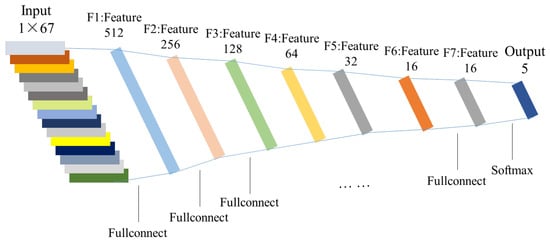
Figure 5.
Network structure of DNN for the 2000s classification.

Table 2.
DNN hyperparameters.
3. Results
3.1. Classification Accuracy Assessment
To evaluate the classification performance more comprehensively, this study employed multiple accuracy metrics, including training accuracy, testing accuracy, overall accuracy (OA), and the Kappa coefficient (Kappa). In addition, for the final selected model, the producer’s accuracy (PA) and user’s accuracy (UA) were further calculated to assess the model’s performance across individual grassland types. These indicators provide both a global and class-specific evaluation of classification effectiveness.
3.1.1. LightGBM
This study initially employed a traditional machine-learning model to assess whether a simpler and more computationally efficient method could perform comparably to deep-learning models. As shown in Table 3, both training and testing accuracies were high, exceeding 90% for both the 1980s and 2000s datasets (91.07%/90.86% and 91.85%/91.69%, respectively). These results indicate that the model was well-fitted and generalized reasonably to unseen data. However, the overall classification performance, measured by OA and Kappa, remained relatively moderate for the 1980s and 2000s at 73.41%/73.98% and 64.6%/63.52%, respectively. This discrepancy suggests that, although the model correctly predicted a substantial proportion of the samples, the classification performance was somewhat unsatisfactory in terms of precision. A moderate Kappa value further indicates that the classification agreement beyond chance was limited.

Table 3.
Accuracy of LightGBM models.
3.1.2. DNN
The training loss and accuracy curves were used to judge the training degree of the model. Figure 6 shows the training curve of the DNN model in the 1980s and the 2000s. It was found that the network had a big fluctuation in the early training period. With the increase in training times and the automatic adjustment of the learning rate, the network accuracy kept improving, and the loss value dropped and stabilized to around 0.1. The training accuracy of neural networks for the 1980s and the 2000s is 93.2% and 95.2%, respectively. The testing accuracy was 94.1% and 95.4%, respectively. The improvement of DNN than LightGBM highlights its superior capacity for modeling complex nonlinear relationships and capturing subtle patterns in high-dimensional data. Given the complexity of the input features, DNN’s multilayer structure allows for deeper feature abstraction and representation. Additionally, DNN tends to generalize better in scenarios with large training datasets, as in this case with one million samples, whereas tree-based models like LightGBM may be more susceptible to overfitting or performance plateaus when feature interactions become highly nonlinear.
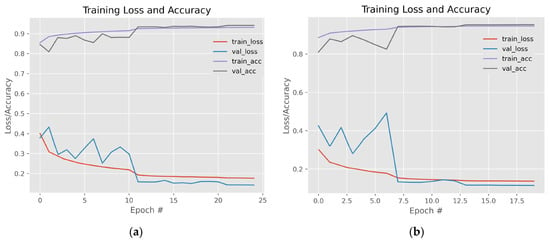
Figure 6.
DNN training loss and accuracy curves for (a) the 1980s, and (b) the 2000s.
According to the confusion matrix (Table 4 and Table 5) of the classification results of the two periods, PA and UA of the TD were the highest in the 1980s, and the classification effect was the best. The TTS and TDS followed. However, the UA of TMS and TSD is relatively low, which may be related to the fact that the number of label samples is less than that of other types. By comparing the spatial distribution, we found that the area proportion of these two grassland types is relatively small, leading to insufficient model learning and a relatively low classification accuracy. In the 2000s, the classification effect of the TD was the best, and the UA reached 98.2%, followed by the TTS. The UA of TMS and TDS is relatively low, which is partly related to the relatively small number of label samples. The OA and Kappa of the DNN model were 79.4% and 72.6% for the 1980s, and 81.1% and 74.1% for the 2000s, respectively. These results are noticeably higher than those achieved by the LightGBM models. The improved performance of the DNN indicates better agreement between the predicted classification and the reference field survey maps. This suggests that the DNN model not only captures the underlying spatial and spectral patterns more effectively, but also generalizes better across different time periods. The higher Kappa values also imply that DNN provides a more reliable classification, further validating its robustness for complex grassland classification tasks.

Table 4.
DNN accuracy of the 1980s.

Table 5.
DNN accuracy of the 2000s.
3.2. Field Reconnaissance Validation
To further verify the prediction performance of the DNN model used for 2010s classification, we conducted a field survey of grassland in eastern Inner Mongolia, China, from July to August 2021. Considering biodiversity, road accessibility, time cost and economic cost of field experiments, etc., the sampling area includes Abaga Banner, Sunite Left Banner, Sunite Right Banner, Erlianhot city, Huide County, Xianghuang Banner, Zhenglan Banner, Xilinhot city, West Ujimqin Banner, East Uzhumqin Banner, New Baerhu Left Banner, New Baerhu Right Banner, and other 13 banner counties. According to the field investigation method of grassland resources [56], we collected 143 quadrats in Inner Mongolia and recorded the data of longitude, latitude, vegetation species, vegetation coverage, and growth status of each quadrat in detail. The DNN model was based on the Chinese vegetation type map in the 1980s and the product data of the Inner Mongolia grassland type survey in 2009. Therefore, referring to the definition of vegetation type map for temperate grassland, we added the grassland types labels to the quadrats recorded in this field reconnaissance.
Since there are no maps or field survey data of grassland types of Inner Mongolia for the 2010s, we assumed that there will be little change in grassland types in 2021 relative to the 2010s. The accuracy of the DNN model for 2010s (2010–2019) was verified by the survey results of all quadrats in 2021. By comparison, 39 quadrats were wrong and 104 quadrats were correct in the prediction results of the DNN model in the 2010s, and the prediction accuracy was 72.7%, which fully demonstrated the reliability of the proposed DNN method application to the classification of temperate grassland types. According to the spatial distribution of field reconnaissance locations (Figure 7), most of the wrongly predicted points are distributed in the transition zone between different grassland types, indicating that the prediction accuracy of the model is relatively low in the transition region, so that it is more necessary to strengthen the differentiation of grassland types in the transition zone in subsequent studies.
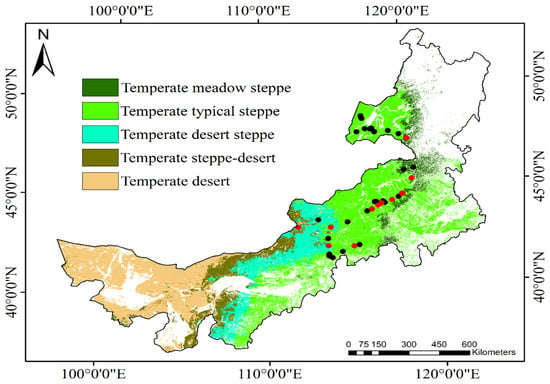
Figure 7.
Field reconnaissance locations of grassland types in Inner Mongolia in 2021.
3.3. Spatiotemporal Variation Analysis of Grassland Types in Grassland Types
The accuracy of the proposed method was verified by field experiments and the reliability of the method was fully demonstrated. The DNN model of the 1980s was used to predict the grassland types distribution in the 1980s and the 1990s, and the DNN model of the 2000s was used to predict the distribution in the 2000s and 2010s. The distribution of the grassland types in Inner Mongolia from 1980 to 2010 were obtained (Figure 8). The changes in grassland types in the three periods of 1980–1990s, 1990–2000s, and 2000–2010s were counted, respectively, and then we counted all the spatial changes from the 1980s to the 2010s. Thus, the entire area can be divided into four variation patterns: No Changes (the region has no changes all the time), Mild Changes (changed in only one period), Moderate Changes (changed in two periods), and Profound Changes (changed in all periods), as shown in Figure 9. According to statistics, the proportion of areas with No Changes, Mild Changes, Moderate Changes, and Profound Changes gradually decreased. Among them, the grassland area in the No Changes area accounted for the most at 61.1%. The Profound Changes area accounted for 23.1%, mainly contributed by changes during the 1990–2000s. The areas with Mild Changes and Moderate Changes accounted for 14.2% and 1.6%, and most are in the transition zone between two adjacent grassland types.
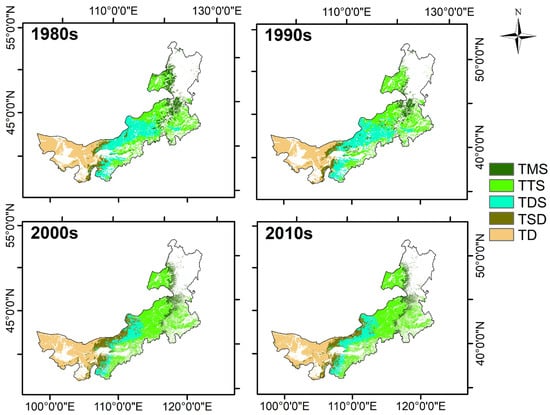
Figure 8.
Spatial distribution of grassland types in Inner Mongolia in the 1980s, 1990s, 2000s, and 2010s.

Figure 9.
Spatiotemporal variation in grassland types in Inner Mongolia.
Through the spatial distribution (Figure 8) and area statistics (Figure 10) of the results, the area of grassland types varied in different levels. The main changes were summarized as follows:
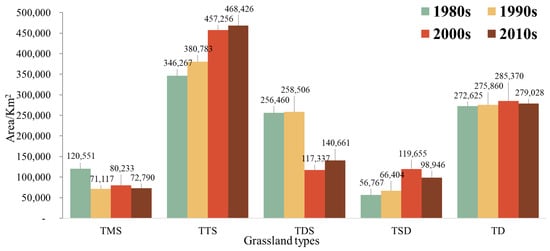
Figure 10.
Area statistics of grassland types in Inner Mongolia in the different ages.
The distribution of temperate grassland from east to west in Inner Mongolia includes five types: temperate meadow steppe (TMS), temperate typical steppe (TTS), temperate desert steppe (TDS), temperate steppe desert (TSD), and temperate desert (TD). The areas of the five grassland types comparatively have the characteristics of TTS > TD > TDS > TSD > TMS.
TTS is the largest grassland type in Inner Mongolia, with a proportion of 39.1%. The areas of TTS in the 1980s, 1990s, 2000s, and 2010s were 346,267 km2, 380,783 km2, 457,256 km2, and 468,426 km2, respectively, showing a continuously increasing trend. A small part of TTS was transformed from TMS, and the greatest part was from TDS. Spatially, its western edge showed a westward-extending trend.
TD is the second largest grassland type in Inner Mongolia, and its area is almost unchanged over time, with an average area of about 278,220 km2 in four periods. Through visual interpretation, it is found that there are only a few spatial transformations between the TD and the TSD.
The areas of TDS in the 1980s, 1990s, 2000s, and 2010s were 256,460 km2, 258,506 km2, 117,337 km2, and 140,661 km2, respectively. After the 2000s, the area decreased significantly, and increased again in the 2010s, but it is still significantly lower than in the 1990s and 1980s. Spatially, it has mainly transformed into TTS and TSD; especially, the TDS in some parts of eastern Inner Mongolia have disappeared. The TDS showed a trend of inward shrinking of the edges of the east and west sides, which may have been caused by the different sources of label data collected in this study.
The areas of TMS and TSD occupied the smallest proportion at 8.2% and 8.1% on average, respectively—86,172.75 km2 and 85,443 km2. From the 1980s to 1990s, the area of the TMS has been drastically reduced by about 49,434 km2, but remained unchanged for the next two decades. Through visual interpretation, we found that the area change mainly occurred at the northeastern. Most of the TMS transformed into TTS, and the TMS generally showed a trend of eastward movement of the west edge and northward movement of the south edge. The area of TSD increased first and then declined; there was a substantial rise of 80.2% between the 1990s and the 2000s. Spatially, the area of TSD has grown largely from desert steppe transitions, and it shows a trend of eastward movement of its eastern edge.
3.4. Grassland Types Changes from the 1980s to 2010s
From the comparison across four continuously periods, it is evident that grassland types have undergone significant changes, with numerous transitions between them. To provide a clear reference for grassland management, this study compares the most recent map with the earliest one. Figure 11 and Figure 12 illustrate the spatial variations and area transitions in temperate grassland types from the 1980s to the 2010s. TMS, primarily dominated by Stipa baicalensis and Leymus chinensis, is one of the major forage sources in Inner Mongolia and plays a crucial role in the region’s livestock industry [57]. However, the area of TMS has undergone a significant negative decrease, shrinking by approximately 39.6%, transitioning into TTS (Figure 11a). Although TTS has expanded considerably, partly due to the conversion of non-grassland areas, its grassland loss rate is nearly equivalent to its gain. Notably, a portion of TTS has experienced a negative decrease of 12,212 km2, mainly transitioning into TDS (Figure 11b). TSD and TD primarily occur in regions with extreme arid conditions and are dominated by drought-tolerant semi-shrubs and shrubs, often accompanied by soil desertification. Overall, the total area of TSD and TD has increased by approximately 15.6%, with spatial expansion trending toward the northeast (Figure 11c). Vegetation types and coverage are crucial indicators for evaluating the grassland degradation [58,59]. Through some negative decrease in grassland types, this study identifies that the phenomenon of grassland degradation happened in Inner Mongolia during the 2010s, particularly in TMS and TSD. Cao et al. pointed out that human activities and environmental changes are the primary drivers of grassland degradation in Inner Mongolia. Human activities contribute significantly to the degradation of TMS grasslands, while climate change, particularly precipitation, also has a substantial impact on temperate grasslands [60].
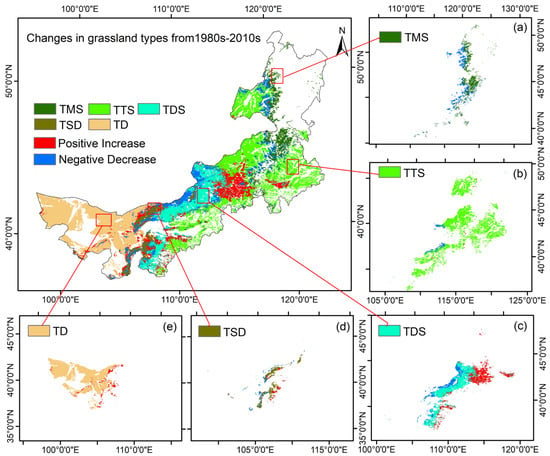
Figure 11.
Spatial changes in temperate grassland types in Inner Mongolia from the 1980s to the 2010s. (a–e) represent the changes in TMS, TTS, TDS, TSD, and TD. From the perspectives of livestock grazing, and sustainable grassland development, grassland types can be ranked in terms of quality as TMS > TTS > TDS > TSD > TD. Based on this classification, transitions from “TD to TMS” are defined as “Positive Increase”, while transitions from “TMS to TD” are considered “Negative Decrease”. Specifically, any transition following the order “TD→TSD→TDS→TTS→TMS” or similar upward shifts (e.g., TSD→TDS, TSD→TTS, TSD→TMS and TDS→TTS, TDS→TMS, TTS→TMS) is regarded as a “Positive Increase”. Conversely, shifts in the opposite direction, such as “TMS→TD”, are classified as “Negative Decrease”.
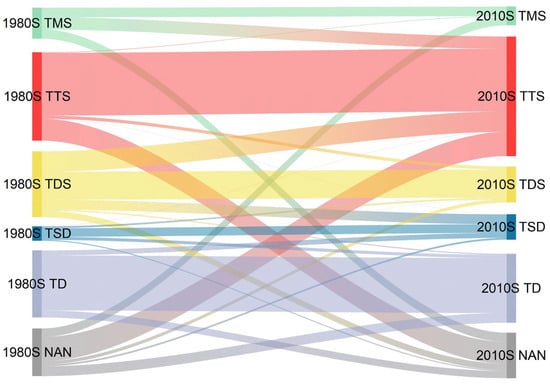
Figure 12.
Sankey diagram of temperate grassland transitions in Inner Mongolia from the 1980s to the 2010s.
4. Discussion
In grassland classification studies, whether different grassland types share similar spectral characteristics or whether the same grassland type exhibits varying spectral features has consistently been a key factor affecting remote sensing classification accuracy. This study, drawing on the growth characteristics of temperate grassland types, tested the performance of DNN models in mapping large-scale temperate grasslands by integrating multi-source data, including soil, topography, meteorological data, and satellite imageries. Using Inner Mongolia as a representative region, we achieved high-accuracy classification results over 40 years for five grassland types: TMS, TTS, TDS, TSD, and TD.
4.1. Advantages of This Workflow
In this study, the traditional ML algorithm LightGBM was first tested using multi-source data. Although LightGBM is capable of capturing nonlinear relationships, its performance was inferior to that of the DNN model. LightGBM achieved slightly lower training and testing accuracies (91.07–91.85% and 90.86–91.6%, respectively) compared to DNN (93.2–95.2% and 94.1–95.4%). More notably, its OA was approximately 71.5%, significantly lower than that of the DNN model, which reached around 80%. These results indicate that, while LightGBM can handle complex data to a certain extent, the DNN model demonstrates a stronger predictive capability and generalization performance. The reliability of the DNN model is supported by multiple aspects, including its predictive accuracy, spatial consistency of classification results, and field validation. Thus, this study not only demonstrates the feasibility of fine-scale grassland classification in Inner Mongolia, but also provides a transferable classification workflow that can be applied to other regional grassland mapping tasks at similar scales, such as boreal grasslands.
Moreover, as the temperate grasslands of Inner Mongolia form a significant part of the Eurasian temperate grassland zone, our approach shows a great potential for extension to other regions within the Eurasian temperate grasslands. While the proposed method offers strong feasibility, it is important to note that the wide geographic span of the Eurasian continent involves substantial heterogeneity in environmental conditions. Therefore, for applications beyond Inner Mongolia, it is necessary to reconstruct region-specific datasets and retrain the model to ensure accurate classification in each subregion. This approach could ultimately enable large-scale, multi-temporal grassland mapping across the entire Eurasian temperate grassland zone.
4.2. Patterns of Grassland Spatiotemporal Distributions and Changes
This study analyzed the grassland changes over multiple periods. Overall, in the four-period average of the whole of Inner Mongolia, the area of TTS (39%) accounted for the largest, and TMS (8.2%) and TSD (8.1%) the smallest amount. In the past 40 years, the area of grassland types has significant changes. The main changes are reflected in TTS, TDS, and TSD, with the TTS continuously increasing, TDS generally declining, and TSD generally increasing. Through visual interpretation, it is found that the TMS spatially showed a trend of eastward movement of the west edge and northward movement of the south edge: the western edge of TTS moved westward; the east and west edges of the TDS shrink inward; the eastern edge of TTS moves eastward; and TD remained almost unchanged.
By comparing the spatial changes from the 1980s to the 2010s, it is evident that there has been some degradation in grassland types. Even though the area of TTS has increased to some extent, a portion of this increase is due to the degradation of TMS. The substantial decline in TMS (by approximately 39.6%) suggests that human activities, such as overgrazing, may have played a crucial role in this degradation, aligning with the findings of Cao et al. [60]. The expansion of TD and TSD have increased with the spatially extending forward TDS, which was probably caused by climate change. While this study defines a “negative decrease” to describe grassland loss, it would be beneficial to adopt more widely recognized ecological degradation metrics to provide a more comprehensive and standardized assessment of grassland degradation. Metrics such as biomass loss can reflect the overall decline in productivity, while changes in dominant species can explain the stability and richness of grassland ecosystem. Additionally, biodiversity changes, including reductions in species richness and alterations in community structure, can offer crucial insights into the long-term ecological consequences of grassland degradation. By incorporating these indicators, future studies could gain a deeper understanding of both the extent and underlying drivers of degradation, facilitating more effective conservation and management strategies.
Statistics show that, over the past 40 years, 61.1% of grassland areas have remained unchanged in type, reflecting the influence of the growth environment and regional characteristics on temperate grasslands. Our study also shows that, over the past 40 years, areas of mild, moderate, and profound change have mostly occurred in transitional zones between different grassland types, which are highly unstable. Grassland types in these transition zones often exhibit mixed growth, while environmental factors such as the terrain, climate, and soil remain largely consistent across them, allowing these areas to be classified as either of the bordering grassland types. However, most grassland classification studies currently define clear boundaries between these two types, and whether it is necessary to develop other reasonable classification methods requires further exploration.
4.3. Limitations
Despite the satisfactory classification accuracy and consistency demonstrated in this study, large-scale remote sensing classification tasks that involve multi-source data and long-term temporal scales are inherently subject to several sources of uncertainty and potential error propagation. These can be categorized into the following three aspects:
Inconsistencies in spatiotemporal resolution of multi-source input features: The integration of diverse datasets—including remote sensing, meteorological, topographic, and soil information—inevitably introduces mismatches in spatial and temporal resolution. For instance, meteorological data typically have a coarser spatial resolution than satellite-derived data. Additionally, the temporal resolution of input features varies across datasets. These mismatches may introduce noise into the model. To mitigate such scale-related issues, careful feature selection was performed. For example, satellite data were sourced from moderate-resolution platforms such as MODIS and NOAA AVHRR, rather than higher-resolution sensors like Landsat, to better match the scale of ancillary data.
Label noise from historical vegetation maps: The ground-truth data in this study were derived from long-term field investigations by domain experts, which, although authoritative, may introduce subjective errors in the grassland type definition. Furthermore, the two historical datasets (1980s and 2009) used in model training were obtained from different institutions and may vary in quality and classification standards. Such inconsistencies can potentially affect model learning and generalization. The availability of more contemporary and high-quality validation datasets would help to further improve classification performance and reliability.
Model bias due to class imbalance and algorithm limitations: Even with high-quality inputs and labels, the model may still introduce systemic bias. For example, certain grassland types with relatively few training samples may be underrepresented in the learning process, leading to a reduced classification accuracy. Conversely, dominant classes may lead to overfitting. Although class-weighting strategies were attempted to mitigate imbalance, they did not yield improvements. To enhance model robustness, techniques such as regularization, dropout, and adaptive optimization were applied in the DNN architecture.
In addition, field validation was conducted across the study area in 2021. However, due to practical constraints such as a limited time and budget, the inaccessibility of some remote regions, and the refusal of certain landowners to permit destructive sampling, the field sampling locations were necessarily limited. Consequently, the validation sites were primarily concentrated in accessible areas, potentially introducing spatial sampling bias. This bias may reduce the representativeness of the validation data. Future studies could mitigate this issue by incorporating additional validation data sources or expanding field campaigns to include a broader and more balanced range of locations.
While our study analyzed the trends over the past 40 years, it did not define the specific causes or degree of degradation, as degradation is a complex, multifaceted concept. Caution is also needed when applying this framework, as the current data integration approach may not be suitable for more detailed species-level classification within grasslands. In summary, our future research will focus on quantifying uncertainty to improve prediction accuracy, investigating the specific causes and drivers of grassland changes, and aiming to provide more targeted recommendations for conservation and management based on these insights.
5. Conclusions
The grassland types distribution map is of great significance for the study of grassland change and protection. In view of the lack of a complete grassland type distribution map over the past 40 years in Inner Mongolia, we proposed a classification method of grassland type using machine learning. Based on the vegetation type maps of Inner Mongolia collected in the 1980s and 2009, sample datasets were firstly constructed. Multi-source features, such as multispectral reflectance, vegetation growth, topography, water body, meteorology, and soil, were selected to reflect the growth characteristics of temperate grassland. Then, DNN classification models were obtained for the classification of grassland types. Finally, the spatial distribution of temperate grassland types in Inner Mongolia from 1981 to 2019 (four decades of 1980s, 1990s, 2000s, and 2010s) were predicted. By field reconnaissance validation, the classification results showed a good classification accuracy. It demonstrated that the DNN can be used as an effective method for temperate grassland classification. Moreover, we analyzed the spatiotemporal variation in the four periods of Inner Mongolia grassland. Averagely, TTS (39.1%) has the largest area, while TMS (8.2%) and TSD (8.1%) is the opposite; the main area changes came from the temperate TTS, TDS, and TSD, while TD remain almost unchanged in time and space; and, through visual interpretation, it was found that, except for TD, the area of other grassland types changes between each other, mainly occurring in grassland types adjacent in space.
This study verified the feasibility of the DNN method in the classification of temperate grassland types and partially enriched the long-term grassland type data of Inner Mongolia grassland. The spatial distribution patterns of the four periods were generally consistent, but there was a significant difference before and after the 2000s; perhaps, due to the label data of two periods collected from different sources maps, there were errors between them due to the subjective factors of human field survey, which, to some extent, affected the classification results. Since it is actually very difficult to obtain other historical survey sample data in the study area so far, the classification results still provided the longest and most complete classification maps of grassland types in this area at present, which are expected to be a good support for grassland research and the conservation of Inner Mongolia grassland. In the future, more research should be carried out to explore the DNN method’s spatial feasibility by application in the whole Eurasia temperate grassland. Moreover, other machine-learning methods such as decision tree, random forest, logistic regression, and deep learning are also needed in order to explore the advantages and potential of other artificial intelligence algorithms in grassland classification by in-depth comparison.
Author Contributions
Conceptualization, X.X. and J.T.; methodology, X.X., J.T. and N.Z.; software, X.X. and Q.S.; validation, X.X., A.Z. and W.W.; data process and analysis, X.X., A.Z., W.W. and Q.S.; investigation, N.Z.; writing—original draft preparation, X.X. and J.T.; writing—review and editing, X.X., J.T., N.Z., A.Z., W.W. and Q.S. All authors have read and agreed to the published version of the manuscript.
Funding
This work was jointly supported by the Science and Technology Fundamental Resources Investigation Program (Grant No. 2022FY100102) funded by the Ministry of Science and Technology of the People’s Republic of China and the CAS Strategic Priority Research Programme (A) (Grant No. XDA20050103).
Data Availability Statement
The data that support the findings of this study are not publicly available, but may be obtained from the corresponding authors, J.T. and N.Z., upon reasonable request.
Acknowledgments
We gratefully acknowledge the NASA, NOAA, and ECMWF for providing the dataset support of MODIS, NOAA, and ERA5 used in this study. Special thanks to the Institute of Botany, Chinese Academy of Sciences and Inner Mongolia Grassland Survey and Planning Institute for the grassland type data support.
Conflicts of Interest
The authors declare no conflicts of interest.
Abbreviations
The following abbreviations are used in this manuscript:
| AAT | Annual Accumulated Temperature |
| ARNCI | Accumulated Rate of NDVI Change Index |
| DEM | Digital Elevation Model |
| DL | Deep Learning |
| DNN | Deep Neural Network |
| GEE | Google Earth Engine |
| Kappa | Kappa Coefficient |
| LightGBM | Light Gradient Boosting Machine |
| ML | Machine Learning |
| NDVI | Normalized Difference Vegetation Index |
| NDWI | Normalized Difference Water Index |
| OA | Overall Accuracy |
| PA | Producer’s Accuracy |
| TDS | Temperate Desert Steppe |
| TD | Temperate Desert |
| TMS | Temperate Meadow Steppe |
| TSD | Temperate Steppe Desert |
| TTS | Temperate Typical Steppe |
| TWI | Topographic wetness index |
| UA | User’s Accuracy |
References
- Liu, Y.; Zhang, Z.; Tong, L.; Khalifa, M.; Wang, Q.; Gang, C.; Wang, Z.; Li, J.; Sun, Z. Assessing the effects of climate variation and human activities on grassland degradation and restoration across the globe. Ecol. Indic. 2019, 106, 105504. [Google Scholar] [CrossRef]
- Ren, H.; Zhou, G. Measuring the impacts of anthropogenic activities on Inner Mongolian temperate grassland. Land Degrad. Dev. 2018, 29, 2942–2950. [Google Scholar] [CrossRef]
- Zhou, W.; Yang, H.; Huang, L.; Chen, C.; Lin, X.; Hu, Z.; Li, J. Grassland degradation remote sensing monitoring and driving factors quantitative assessment in China from 1982 to 2010. Ecol. Indic. 2017, 83, 303–313. [Google Scholar] [CrossRef]
- Hou, Q.; Ji, Z.; Yang, H.; Yu, X. Impacts of climate change and human activities on different degraded grassland based on NDVI. Sci. Rep. 2022, 12, 15918. [Google Scholar] [CrossRef] [PubMed]
- Naidoo, R.; Hill, K. Emergence of Indigenous Vegetation Classifications Through Integration of Traditional Ecological Knowledge and Remote Sensing Analyses. Environ. Manag. 2006, 38, 377–387. [Google Scholar] [CrossRef] [PubMed]
- Guo, Q.; Guan, H.; Hu, T.; Jin, S.; Su, Y.; Wang, X.J.; Sun, Q.H. Remote sensing-based mapping for the new generation of Vegetation Map of China (1:500,000). Sci. Sin. Vitae 2021, 51, 229–241. (In Chinese) [Google Scholar] [CrossRef]
- Liu, X.; Zhang, D.; Wang, H.; Ren, Z.; Han, T.; Sun, B.; Pan, D.; Wang, B. GIS-based analysis of the compatibility of two grassland classification systems in China. Acta Pratacult. Sin. 2019, 28, 1–18. (In Chinese) [Google Scholar]
- Su, Y.; Guo, Q.; Hu, T.; Guan, H.; Jin, S.; An, S.; Chen, X.; Guo, K.; Hao, Z.; Hu, Y.; et al. An updated Vegetation Map of China (1:1,000,000). Sci. Bull. 2020, 65, 1125–1136. [Google Scholar] [CrossRef]
- 1:1,000,000 China Grassland Resource Mapping Committee. 1:1 Million Atlas of Grassland Resources in China; China Cartographic Publishing House: Beijing, China, 1993. [Google Scholar]
- Friedl, M.A.; McIver, D.K.; Hodges, J.C.F.; Zhang, X.Y.; Muchoney, D.; Strahler, A.H.; Woodcock, C.E.; Gopal, S.; Schneider, A.; Cooper, A.; et al. Global land cover mapping from MODIS: Algorithms and early results. Remote Sens. Environ. 2002, 83, 287–302. [Google Scholar] [CrossRef]
- Karra, K.; Kontgis, C.; Statman-Weil, Z.; Mazzariello, J.C.; Mathis, M.; Brumby, S.P. Global land use/land cover with Sentinel 2 and deep learning. In Proceedings of the 2021 IEEE International Geoscience and Remote Sensing Symposium (IGARSS), Brussels, Belgium, 11–16 July 2021. [Google Scholar] [CrossRef]
- Li, B.; Xu, X.; Liu, X.; Shi, Q.; Zhuang, H.; Cai, Y.; He, D. An improved global land cover mapping in 2015 with 30 m resolution (GLC-2015) based on a multisource product-fusion approach. Earth Syst. Sci. Data 2023, 15, 2347–2373. [Google Scholar] [CrossRef]
- Phiri, D.; Morgenroth, J. Developments in Landsat Land Cover Classification Methods: A Review. Remote Sens. 2017, 9, 967. [Google Scholar] [CrossRef]
- Xu, P.; Tsendbazar, N.E.; Herold, M.; de Bruin, S.; Koopmans, M.; Birch, T.; Carter, S.; Fritz, S.; Lesiv, M.; Mazur, E.; et al. Comparative validation of recent 10 m-resolution global land cover maps. Remote Sens. Environ. 2024, 311, 114316. [Google Scholar] [CrossRef]
- Zanaga, D.; Van De Kerchove, R.; Daems, D.; de Keersmaecker, W.; Brockmann, C.; Kirches, G.; Wevers, J.; Cartus, O.; Santoro, M.; Fritz, S.; et al. ESA WorldCover 10 m 2021 v200 (Version v200). Zenodo 2022. [Google Scholar] [CrossRef]
- Zhao, Y.; Zhu, W.; Wei, P.; Fang, P.; Zhang, X.; Yan, N.; Liu, W.; Zhao, w.; Wu, Q. Classification of Zambian grasslands using random forest feature importance selection during the optimal phenological period. Ecol. Indic. 2022, 135, 108529. [Google Scholar] [CrossRef]
- Lu, B.; He, Y. Species classification using Unmanned Aerial Vehicle (UAV)-acquired high spatial resolution imagery in a heterogeneous grassland. ISPRS J. Photogramm. 2017, 128, 73–85. [Google Scholar] [CrossRef]
- Sun, Y.; Yi, S.; Hou, F. Unmanned aerial vehicle methods makes species composition monitoring easier in grasslands. Ecol. Indic. 2018, 95, 825–830. [Google Scholar] [CrossRef]
- Wei, D.; Liu, K.; Xiao, C.; Sun, W.; Liu, W.; Liu, L. A Systematic Classification Method for Grassland Community Division Using China’s ZY1-02D Hyperspectral Observations. Remote Sens. 2022, 14, 3751. [Google Scholar] [CrossRef]
- Yang, H.; Du, J.; Wang, Y.; Zhang, Y.; Zhang, X.; Kang, Y. Classification Method of Grassland Species Based on Unmanned Aerial Vehicle Remote Sensing and Convolutional Neural Network. Trans. Chin. Soc. Agric. Mach. 2019, 50, 188–195. (In Chinese) [Google Scholar]
- Schulze-Brüninghoff, D.; Wachendorf, M.; Astor, T. Remote sensing data fusion as a tool for biomass prediction in extensive grasslands invaded by L. polyphyllus. Remote Sens. Ecol. Conserv. 2021, 7, 198–213. [Google Scholar] [CrossRef]
- Wang, W.; Tang, J.; Zhang, N.; Wang, Y.; Xu, X.; Zhang, A. Spatiotemporal Pattern of Invasive Pedicularis in the Bayinbuluke Land, China, during 2019–2021: An Analysis Based on PlanetScope and Sentinel-2 Data. Remote Sens. 2023, 15, 4383. [Google Scholar] [CrossRef]
- Liu, M.; Qu, Y.; Wang, J.; Liao, Y.; Zheng, G.; Guo, Y.; Liu, L. A 30-m annual grassland dataset from 1991 to 2020 for Inner Mongolia, China. Sci. Data 2024, 11, 1143. [Google Scholar] [CrossRef]
- Meng, B.; Yang, Z.; Yu, H.; Qin, Y.; Sun, Y.; Zhang, J.; Chen, J.; Wang, Z.; Wang, W.; Li, M.; et al. Mapping of Kobresia pygmaea Community Based on Umanned Aerial Vehicle Technology and Gaofen Remote Sensing Data in Alpine Meadow Grassland: A Case Study in Eastern of Qinghai–Tibetan Plateau. Remote Sens. 2021, 13, 2483. [Google Scholar] [CrossRef]
- Yu, H.; Zhu, L.; Chen, Y.; Yue, Z.; Zhu, Y. Improving grassland classification accuracy using optimal spectral-phenological-topographic features in combination with machine learning algorithm. Ecol. Indic. 2024, 158, 111392. [Google Scholar] [CrossRef]
- Han, P.; Zhao, X.; Dong, Z.; Yan, Y.; Niu, J.; Zhang, Q. A new approach for the classification of grassland utilization in Inner Mongolia—Based on ecological sites and state-and-transition models. Ecol. Indic. 2022, 137, 108733. [Google Scholar] [CrossRef]
- Xu, X.; Tang, J.; Zhang, N.; Zhang, A.; Wang, W.; Sun, Q. Remote Sensing Classification of Temperate Grassland in Eurasia Based on Normalized Difference Vegetation Index (NDVI) Time-Series Data. Sustainability 2023, 15, 14973. [Google Scholar] [CrossRef]
- Meng, B.; Zhang, Y.; Yang, Z.; Lv, Y.; Chen, J.; Li, M.; Sun, Y.; Zhang, H.; Yu, H.; Zhang, J.; et al. Mapping Grassland Classes Using Unmanned Aerial Vehicle and MODIS NDVI Data for Temperate Grassland in Inner Mongolia, China. Remote Sens. 2022, 14, 2094. [Google Scholar] [CrossRef]
- Zhang, L.; Zhang, L.; Du, B. Deep Learning for Remote Sensing Data: A Technical Tutorial on the State of the Art. IEEE Geosci. Remote Sens. Mag. 2016, 4, 22–40. [Google Scholar] [CrossRef]
- Ullah, S.; Si, Y.; Schlerf, M.; Skidmore, A.K.; Shafique, M.; Iqbal, I.A. Estimation of grassland biomass and nitrogen using MERIS data. Int. J. Appl. Earth Obs. Geoinf. 2012, 19, 196–204. [Google Scholar] [CrossRef]
- Zhou, Y.; Liu, T.; Batelaan, O.; Duan, L.; Wang, Y.; Li, X.; Li, M. Spatiotemporal fusion of multi-source remote sensing data for estimating aboveground biomass of grassland. Ecol. Indic. 2023, 146, 109892. [Google Scholar] [CrossRef]
- Yang, S.; Feng, Q.; Liang, T.; Liu, B.; Zhang, W.; Xie, H. Modeling grassland above-ground biomass based on artificial neural network and remote sensing in the Three-River Headwaters Region. Remote Sens. Environ. 2018, 204, 448–455. [Google Scholar] [CrossRef]
- Lyu, X.; Li, X.; Gong, J.; Li, S.; Dou, H.; Dang, D.; Xuan, X.; Wang, H. Remote-sensing inversion method for aboveground biomass of typical steppe in Inner Mongolia, China. Ecol. Indic. 2021, 120, 106883. [Google Scholar] [CrossRef]
- Shi, Y.; Gao, J.; Li, X.; Perry, G.L.W.; Xu, T. Improving the accuracy of models to map alpine grassland above-ground biomass using Google earth engine. Grass Forage Sci. 2023, 78, 2. [Google Scholar] [CrossRef]
- Geng, Y.; Wang, Z.; Liang, C.; Fang, J.; Baumann, F.; Kühn, P.; Scholten, T.; He, J. Effect of geographical range size on plant functional traits and the relationships between plant, soil and climate in Chinese grasslands. Glob. Ecol. Biogeogr. 2012, 21, 416–427. [Google Scholar] [CrossRef]
- Gibson, D.; Newman, J. Grasslands and Climate Change; Cambridge University Press: Cambridge, UK, 2019. [Google Scholar] [CrossRef]
- Ma, R.; Xia, C.; Liu, Y.; Wang, Y.; Zhang, J.; Shen, X.; Lu, X.; Jiang, M. Spatiotemporal Change of Net Primary Productivity and Its Response to Climate Change in Temperate Grasslands of China. Front. Plant Sci 2022, 13, 899800. [Google Scholar] [CrossRef]
- Guo, Q.; Li, S.; Hu, Z.; Zhao, W.; Yu, G.; Sun, X.; Liang, N.; Bai, W. Responses of gross primary productivity to different sizes of precipitation events in a temperate grassland ecosystem in Inner Mongolia, China. J. Arid. Land 2016, 8, 36–46. [Google Scholar] [CrossRef]
- Babbar-Sebens, M.; Barr, R.C.; Tedesco, L.P.; Anderson, M. Spatial identification and optimization of upland wetlands in agricultural watersheds. Ecol. Eng. 2013, 52, 130–142. [Google Scholar] [CrossRef]
- Guo, J.; Yang, X.; Chen, F.; Niu, J.; Luo, S.; Zhang, M.; Jin, Y.; Shen, G.; Chen, A.; Xing, X.; et al. Examining Relationships between Heat Requirement of Remotely Sensed Green-Up Date and Meteorological Indicators in the Hulun Buir Grassland. Remote Sens. 2021, 13, 1044. [Google Scholar] [CrossRef]
- Liu, Y.; Liu, S.; Sun, Y.; Li, M.; An, Y.; Shi, F. Spatial differentiation of the NPP and NDVI and its influencing factors vary with grassland type on the Qinghai-Tibet Plateau. Environ. Monit. Assess. 2021, 193, 48. [Google Scholar] [CrossRef] [PubMed]
- Ren, J.Z.; Hu, Z.Z.; Zhao, J.; Zhang, D.G.; Hou, F.J.; Lin, H.L.; Mu, X.D. A grassland classification system and its application in China. Rangel. J. 2008, 30, 199–209. [Google Scholar] [CrossRef]
- Wu, Z.; Zhang, J.; Deng, F.; Zhang, S.; Zhang, D.; Xun, L.; Javed, T.; Liu, G.; Liu, D.; Ji, M. Fusion of GF and MODIS Data for Regional-Scale Grassland Community Classification with EVI2 Time-Series and Phenological Features. Remote Sens. 2021, 13, 835. [Google Scholar] [CrossRef]
- Yang, W.; Wang, Y.; He, C.; Tan, X.; Han, Z. Soil Water Content and Temperature Dynamics under Grassland Degradation: A Multi-Depth Continuous Measurement from the Agricultural Pastoral Ecotone in Northwest China. Sustainability 2019, 11, 4188. [Google Scholar] [CrossRef]
- Lu, B.; He, Y. Optimal spatial resolution of Unmanned Aerial Vehicle (UAV)-acquired imagery for species classification in a heterogeneous grassland ecosystem. GISci. Remote Sens. 2018, 55, 205–220. [Google Scholar] [CrossRef]
- Reuter, H.I.; Nelson, A.; Jarvis, A. An evaluation of void-filling interpolation methods for SRTM data. Int. J. Geogr. Inf. Sci. 2007, 21, 983–1008. [Google Scholar] [CrossRef]
- Li, Z.Y.; Zhang, N. Data Set of Soil Physical and Chemical Indexes of Temperate Grassland in Eurasia (1981–2019); National Tibetan Plateau Data Center: Beijing, China, 2021. (In Chinese) [Google Scholar]
- Gorelick, N.; Hancher, M.; Dixon, M.; Ilyushchenko, S.; Thau, D.; Moore, R. Google Earth Engine: Planetary-scale geospatial analysis for everyone. Remote Sens. Environ. 2017, 202, 18–27. [Google Scholar] [CrossRef]
- Ke, G.; Meng, Q.; Finley, T.; Wang, T.; Chen, W.; Ma, W.; Ye, Q.; Liu, T.-Y. Lightgbm: A Highly Efficient Gradient Boosting Decision Tree. Adv. Neural Inf. Process. Syst. 2017, 30, 1–9. [Google Scholar]
- Bui, Q.-T.; Chou, T.-Y.; Hoang, T.-V.; Fang, Y.-M.; Mu, C.-Y.; Huang, P.-H.; Pham, V.-D.; Nguyen, Q.-H.; Anh, D.T.N.; Pham, V.-M.; et al. Gradient Boosting Machine and Object-Based CNN for Land Cover Classification. Remote Sens. 2021, 13, 2709. [Google Scholar] [CrossRef]
- Suthaharan, S. Support Vector Machine. In Machine Learning Models and Algorithms for Big Data Classification; Integrated Series in Information Systems; Springer: Boston, MA, USA, 2016; Volume 36. [Google Scholar]
- Biau, G. Analysis of a random forests model. J. Mach. Learn. Res. 2012, 13, 1063–1095. [Google Scholar]
- LeCun, Y.; Bengio, Y.; Hinton, G. Deep learning. Nature 2015, 521, 436–444. [Google Scholar] [CrossRef]
- Rawat, A.; Kumar, A.; Upadhyay, P.; Kumar, S. Deep learning-based models for temporal satellite data processing: Classification of paddy transplanted fields. Ecol. Inform. 2021, 61, 101214. [Google Scholar] [CrossRef]
- Schmidhuber, J. Deep learning in neural networks: An overview. Neural Netw. 2015, 61, 85–117. [Google Scholar] [CrossRef]
- Rodwell, J.S. The UK National Vegetation Classification. Phytocoenologia 2018, 48, 133–140. [Google Scholar] [CrossRef]
- Liu, Z.; Wang, W.; Hao, H.; Liang, C. Probes on the Degeneration and Recovery Succession Mechanisms of Inner Mongolia Steppe. J. Arid. Land Resour. Environ. 2002, 1, 84–91. (In Chinese) [Google Scholar]
- Wiesmair, M.; Feilhauer, H.; Magiera, A.; Otte, A.; Waldhardt, R. Estimating vegetation cover from high-resolution satellite data to assess grassland degradation in the Georgian Caucasus. Mt. Res. Dev. 2016, 36, 56–65. [Google Scholar] [CrossRef]
- Zheng, H.; Huang, T.; Zhang, W.; Song, C.; Zhang, Q.; Sun, W.; Yu, Y.; Yu, L.; Li, H.; Zhang, C.; et al. The implementation of ecological protection in Inner Mongolia has slowed down grassland degradation. Fundam. Res. 2024; in press. [Google Scholar] [CrossRef]
- Cao, F.; Liu, L.; Rong, Y.; Jiang, N.; Zhao, L.; Zhang, Q.; Wu, Z.; Zhao, W.; Li, S. Climate change enhances greening while human activities accelerate degradation in northern China’s grasslands. Sci. Total Environ. 2025, 966, 178570. [Google Scholar] [CrossRef]
Disclaimer/Publisher’s Note: The statements, opinions and data contained in all publications are solely those of the individual author(s) and contributor(s) and not of MDPI and/or the editor(s). MDPI and/or the editor(s) disclaim responsibility for any injury to people or property resulting from any ideas, methods, instructions or products referred to in the content. |
© 2025 by the authors. Licensee MDPI, Basel, Switzerland. This article is an open access article distributed under the terms and conditions of the Creative Commons Attribution (CC BY) license (https://creativecommons.org/licenses/by/4.0/).